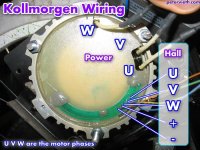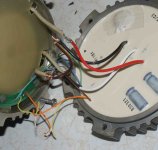It flies apart somewhere around 60v. 48v should be safe.
I dont' think it would be too easy to open up the other side of the housing without risking drilling into the windings. If you used an end mill and were very careful about breaking through, possibly.
You might be able to circulate air in and out from the plate side. Heat from the windings is conducted pretty well to the outer housing, so you could just cool the outside.
I dont' think it would be too easy to open up the other side of the housing without risking drilling into the windings. If you used an end mill and were very careful about breaking through, possibly.
You might be able to circulate air in and out from the plate side. Heat from the windings is conducted pretty well to the outer housing, so you could just cool the outside.



